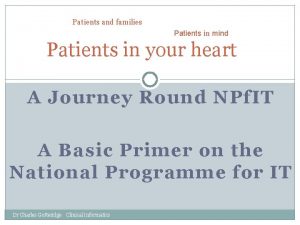Communication with patients Communication Standards Use phrases that










- Slides: 10

Communication with patients

Communication Standards • Use phrases that are easily understood • Should convey your dedication to provide the highest quality healthcare

Establish a Connection • Create an environment of open dialogue and trust • FIVE IMPORTANT KEY POINTS IN DELIVERING HIGH PATIENT SATISFACTION • C: Compassionate Communication • P. Patient Information/Pain Management • R. Response

C. P. R Requires Consistent Delivery of the Following: • Communicate to the patient who you are, what you do and who are the members of the team. • Inform the patient daily what their plan is for the day and set expectations – write on the whiteboard. • Inform the patient and family if they have any questions, concerns to call - you are here to help. • Encourage the patient to communicate how we are doing in managing their pain – their comfort is vital! • Include the patient – tell them what you are doing in the room.

Helpful Patient Comfort/Communication Strategies • Conduct an environmental assessment (e. g. Can the patient reach the telephone, tissue, trash can, TV controls, food tray, water) • Ensure each patient is covered and comfortable • Tell the patient that you round routinely to check comfort levels

• Ask the patient if there is anything else you can do for them prior to leaving the room • Tell the patient when you will be returning • Tell the patient when you are going off shift and the name of the nurse who will be replacing you. When possible, bring the replacing nurse into the room and introduce the nurse to the patient.

• Acknowledge—Acknowledge the patient by name. Make eye contact, smile – remember the power of touch. • Introduce—Introduce yourself, share with the patient a little bit about yourself. • Duration—Give an accurate time expectation for tests, physician arrival and tray delivery, etc. • Explanation—Explain step by step what will happen, answer questions and how you can be reached. • Thank—Thank the patient for coming to you. Thank the family for assistance and being there to support the patient.

IMPORTANT KEY PHRASES • • • No, or I can’t What I can do is…. I don’t know I’ll find out for you. That’s not my job I’ll get someone to help you. Your right, this stinks I understand your concerns. That’s not my fault Let’s see what we can do about this.

• We’re short staffed Tell me how I can help you. • Calm down I am sorry you feel… • I’m busy right now I’ll be with you in just a moment. • I’ll tell you how to go there I’ll take you where you need to go. • I can’t release any information to you As I am sure you understand, patient privacy is very important. Let me check with the patient first.

Poor communication with patients • Situation 1 • Situation 2 • Activity 01



















